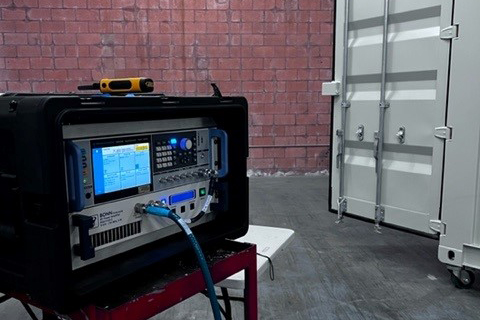An overview of how TEMPEST testing is conducted
If you’re constructing a SCIF or SAPF, part of your requirements will include meeting TEMPEST standards for radio frequency (RF) shielding. This is a crucial part of both your facility security and your accreditation. The requirements for these tests are laid out in Institute of Electrical and Electronics Engineers (IEEE) 299, the Standard Method for Measuring the Effectiveness of Electromagnetic Shielding Enclosures.

SE Testing Antenna
These requirements cover how to space out where the measurements will need to be taken on a wall or door. For example, a typical door assembly will have 14 points that will be tested, and you’ll need to test all penetrations. Different frequencies will require different lengths of tests. You’ll need to test along all seams that are welded, clamped or screwed shut. Depending on if your walls are shorter or higher than three meters, you’ll either measure two or three points per seam. When planning for where to test, you must take the six-sided-box approach, meaning you’ll be testing all four walls as well as the floor and ceiling. These tests take around a minute each, including setup, for each point at least, but this can add up quickly. For example, you run a minimum of 154 tests on the door, meaning the doors alone will take more than two hours to test completely.
These tests consist of an antenna that transmits a signal from one side of a wall or closed door and a receiver to pick up the signal on the other side. The receiver will be hooked up to equipment that will interpret how much of the signal is being picked up in decibels, and this information will be used to calculate the Shielding Effectiveness (SE) of the point that’s being tested. SE is measured in decibels per meter and decibel microvolt per meter. All signals that the receiver doesn’t pick up on are the shielded signals, meaning they’ve been shielded by the RF protection measures you’ve incorporated into your space. You’ll repeat this test on each point with every frequency you need to test.
The IEEE lays out 11 different frequencies you’ll need to test each point at, though you can test further frequencies if you wish. Ideally, these frequencies will be selected by the client, but if not, you’ll try not to cause any interference with radio services in the area, like police or airport communications, when selecting what frequencies to test. With the requirements for how you space out the points you test and the multiple frequencies you need to test, even a small space will easily require more than 1,000 individual tests, and that will increase quickly in larger spaces.
When testing, you’ll either orient the transmitter releasing the signal horizontally or vertically, depending on the direction of the seam. At points where the seam goes both directions and at penetrations, you’ll have to test them both horizontally and vertically in separate tests. These are the points at which you have the most risk of unintended emanations escaping from your facility. The door and penetrations require more tests than your wall to make sure they’re properly sealed.

SE Testing Transmitting Equipment
The equipment required for these tests is highly specialized. If you’re looking to purchase some, it will run you several hundred thousand dollars. Alternatively, you can contract out companies who will test your facility for you. In these cases, they can also provide a detailed report on their findings as well as recommendations for how to reinforce any shielding that does not meet your facility’s requirements.
If you’re looking to outsource your testing, Adamo offers expert SE testing services tailored to your facility. Contact us today to learn about how we can ensure your facility’s TEMPEST protections meet your requirements and provide insight on how to further shield your SCIF or SAPF.



